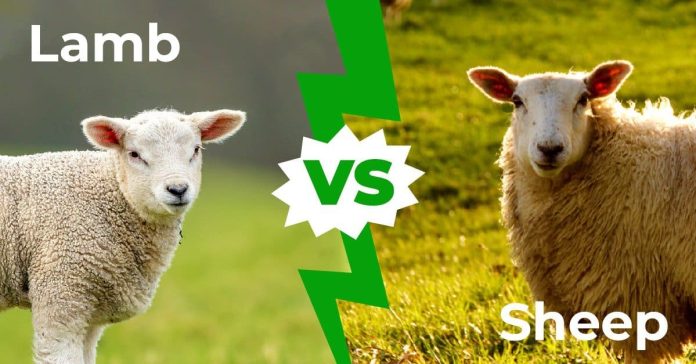Sheep vs Lamb: Understanding the Differences. Read this comprehensive article to learn more about the differences between sheep and lambs. Discover more about sheep and lambs, their characteristics, breeds, and culinary applications.
Learn how to utilize these delectable ingredients in your culinary creations, from age and size variations to variations in meat quality and tenderness. Discover the nutritional value of lamb as well as the distinct qualities of sheep meat, commonly referred to as mutton.
Table of Contents
What is Sheep?
Animals raised primarily for their wool, milk, and meat are sheep, which are domesticated ruminants.
Their herding instincts and herbivorous diet have made them well-known for thousands of years and they have been domesticated for thousands of years. Various breeds of sheep exist, each of which has unique characteristics.
Breeds of Sheep
Several sheep breeds are found throughout the world, including Merino, Suffolk, Dorper, and Texel. There are many characteristics associated with each breed, such as the fine wool produced by the Merino or the excellent meat produced by the Suffolk. Breed selection is dependent on the specific objectives of the farmer as well as the environmental conditions in the area.
Characteristics
A sheep is an herbivore with a complex digestive system that allows it to extract nutrients from plant matter efficiently. The thick woolly coat of these animals protects them from harsh weather conditions. It is important to note that sheep are also equipped with a keen sense of hearing as well as a strong flocking instinct, making them social and group-oriented animals.
What is Lamb?
Lambs are young sheep, usually younger than one year of age. The tender meat of these animals is highly valued and they are often utilized in culinary preparations. To get the most out of lamb, it is essential to understand its stages and its nutritional value.
Stages of Lamb
Lamb meat is classified into three categories according to its age: milk-fed lamb, baby lamb, and spring lamb. A milk-fed lamb is a lamb that has been solely fed milk by its mother, which results in a delicate and mild flavor.
A baby lamb is slightly older than an adult lamb, and he or she is typically weaned and fed milk and solid food simultaneously. The spring lamb is the oldest and has the strongest flavor of the three stages.
Nutritional Value
The meat of lamb contains a variety of essential nutrients, including proteins, vitamins, and minerals. The food contains high-quality protein, an essential component of the growth, repair, and maintenance of the body’s tissues. Moreover, lamb is an excellent source of iron, zinc, and vitamin B12, which are all essential for good health.
Differences Between Sheep and Lamb

Let us now take a closer look at the differences between sheep and lambs so that we have a basic understanding of sheep and lambs.
Age and Size
The age and size of sheep and lambs are two of the most important differences between them. Sheep are mature animals who have reached the age of maturity, generally older than one year of age. As a result of their fully developed bodies, they can weigh anywhere between 100 and 300 pounds, based on the breed of the animal.
A lamb, on the other hand, is still a young animal and is still growing. It is typical that they are less than one year of age and weigh between forty and one hundred pounds. Lambs and sheep differ in age and size, which contributes to differences in the quality and tenderness of their meat.
Meat Quality
There are notable differences in meat quality between sheep and lamb. Tenderness, succulence, and delicate flavor make lamb meat a popular choice among consumers. A younger animal has less connective tissue, so the meat is more tender. This leads to a more enjoyable dining experience for the consumer.
Sheep meat, commonly referred to as mutton, is known for its stronger flavor and firmer texture due to the age of the animal. Despite some people’s preference for the robust taste of mutton, others prefer the flavor of lamb.
Culinary Uses
Sheep and lamb are suitable for different applications in the culinary arts due to their differences in quality and flavor. Various dishes are prepared with lamb, which has tender meat and a milder flavor. There are a variety of traditional recipes using lamb, including lamb chops, stews, kebabs, and roasts. Lamb’s delicate flavor allows it to complement a wide range of herbs, spices, and marinades, making it a versatile choice for a wide variety of culinary applications.
While sheep meat, or mutton, is preferred in dishes that benefit from its stronger and more pronounced flavor. A hearty stew, curry, or braised dish can be enhanced with mutton by adding depth and richness. The firmer texture of mutton makes it ideal for slow-cooking methods that have the benefit of allowing the meat to tenderize over an extended period.
Must Read: Health Benefits of Black Chicken Meat & Where to Find Black Chicken Meat?
Conclusion
While sheep and lambs are closely related, they have distinct characteristics that distinguish them from one another. A sheep is a mature animal, whereas a lamb is a young animal still growing.
The meat of lamb is valued for its tenderness and delicate flavor, whereas the meat of sheep, known as mutton, is prized for its strong flavor and firmer texture. When selecting meat for our meals, it is important to understand these differences to appreciate the culinary nuances.



